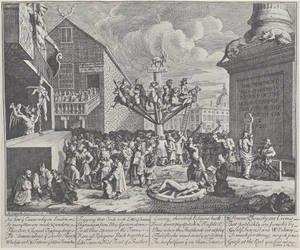Emblematical Print on the South Sea Scheme
| Emblematical Print on the South Sea Scheme | |
|---|---|
 |
|
| Artist | William Hogarth |
| Year | 1721 |
| Type | Engraving |
| Dimensions | 22.2 cm × 31.8 cm (8.8 in × 12.5 in) |
Emblematical Print on the South Sea Scheme (also known as The South Sea Scheme) is an early print by William Hogarth, created in 1721 and widely published from 1724. It caricatures the financial speculation, corruption and credulity that caused the South Sea Bubble in England in 1720–1.
The South Sea Company was a British founded in 1711. It was granted a monopoly to trade with Spain's South American colonies as part of a treaty during the War of Spanish Succession, in return for the company's assumption of the national debt run up by England during the war. Speculation in the company's stock led to a great economic bubble in 1720, with company's shares rising rapidly in price from around £100 to over £1,000. Many investors were ruined when the bubble burst and the value of stock in the South Sea Company crashed. Political scandal ensued when fraud among the company's directors and corruption of cabinet ministers became clear.
The event triggered several satirical engravings by foreign artists that were widely published in English newspapers, including in particular a version of A Monument Dedicated to Posterity by Bernard Picart adapted by Bernard Baron, which depicted Folly drawing Fortune in a cart while she showered a crowd of hopeful investors with bubbles of air and worthless shreds of paper rather than with the riches for which they hoped. Hogarth's print was created in 1721 as a response to the foreign engravings. The events had personal piquancy for Hogarth, given his father's detention as a debtor in Fleet Prison from 1707–12 and his early death in 1718. The South Sea Scheme is an early essay in engraving by Hogarth, who had set up on his own as a copperplate artist and painter after his apprenticeship with silver engraver Ellis Gamble came to an early end in 1720.
...
Wikipedia
